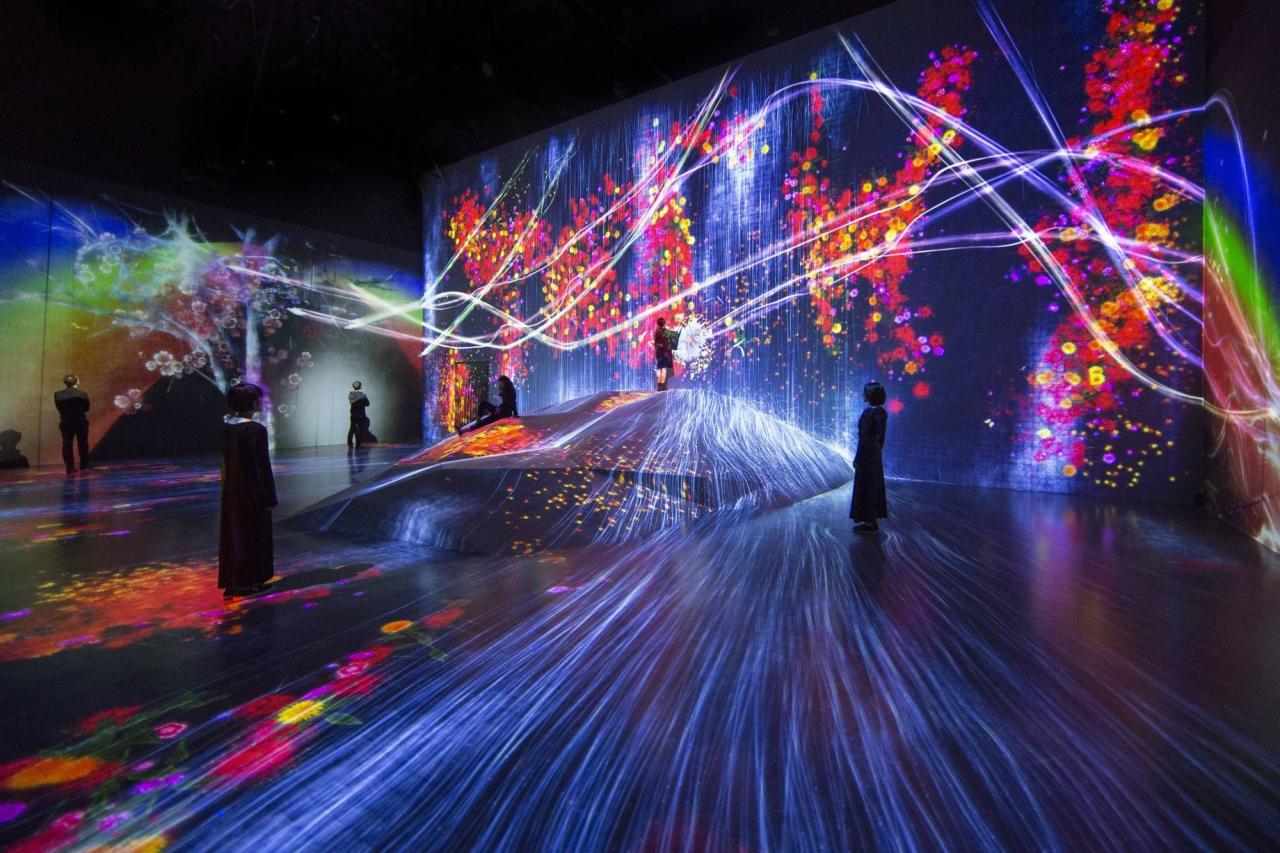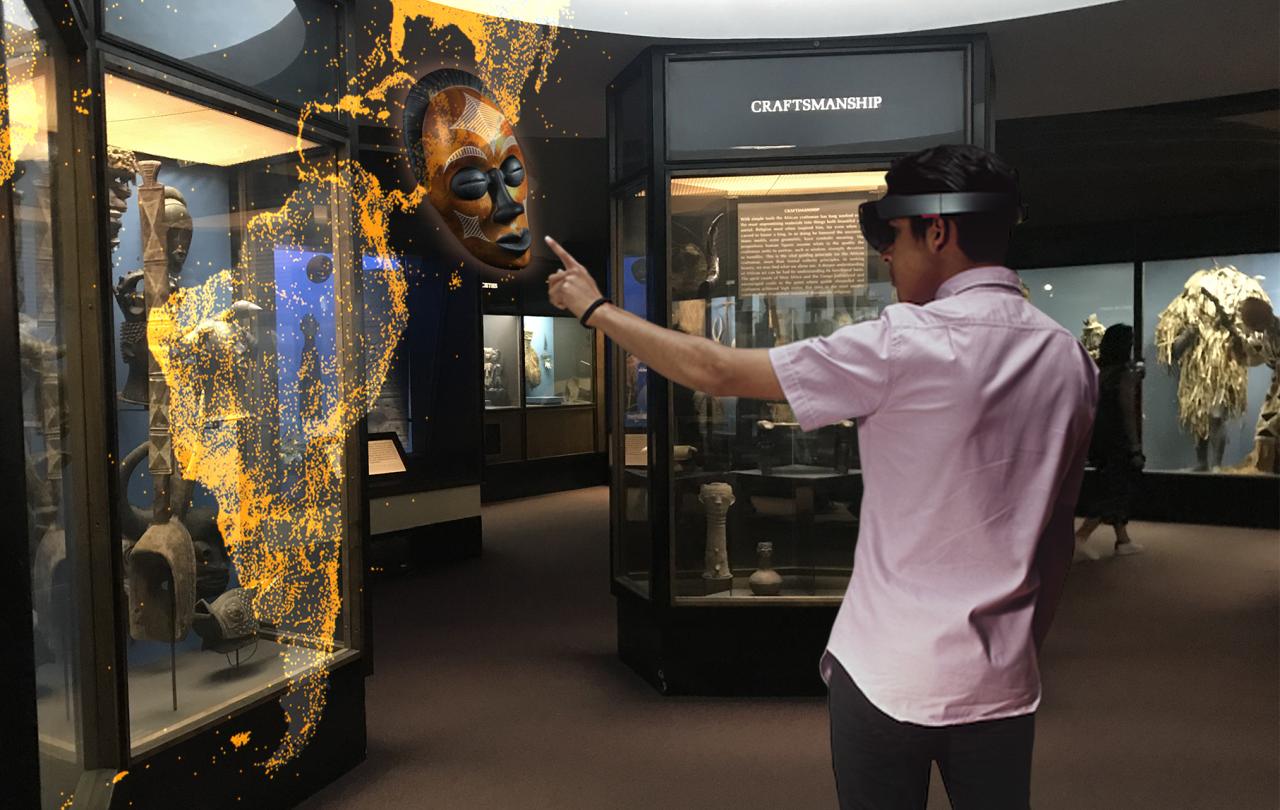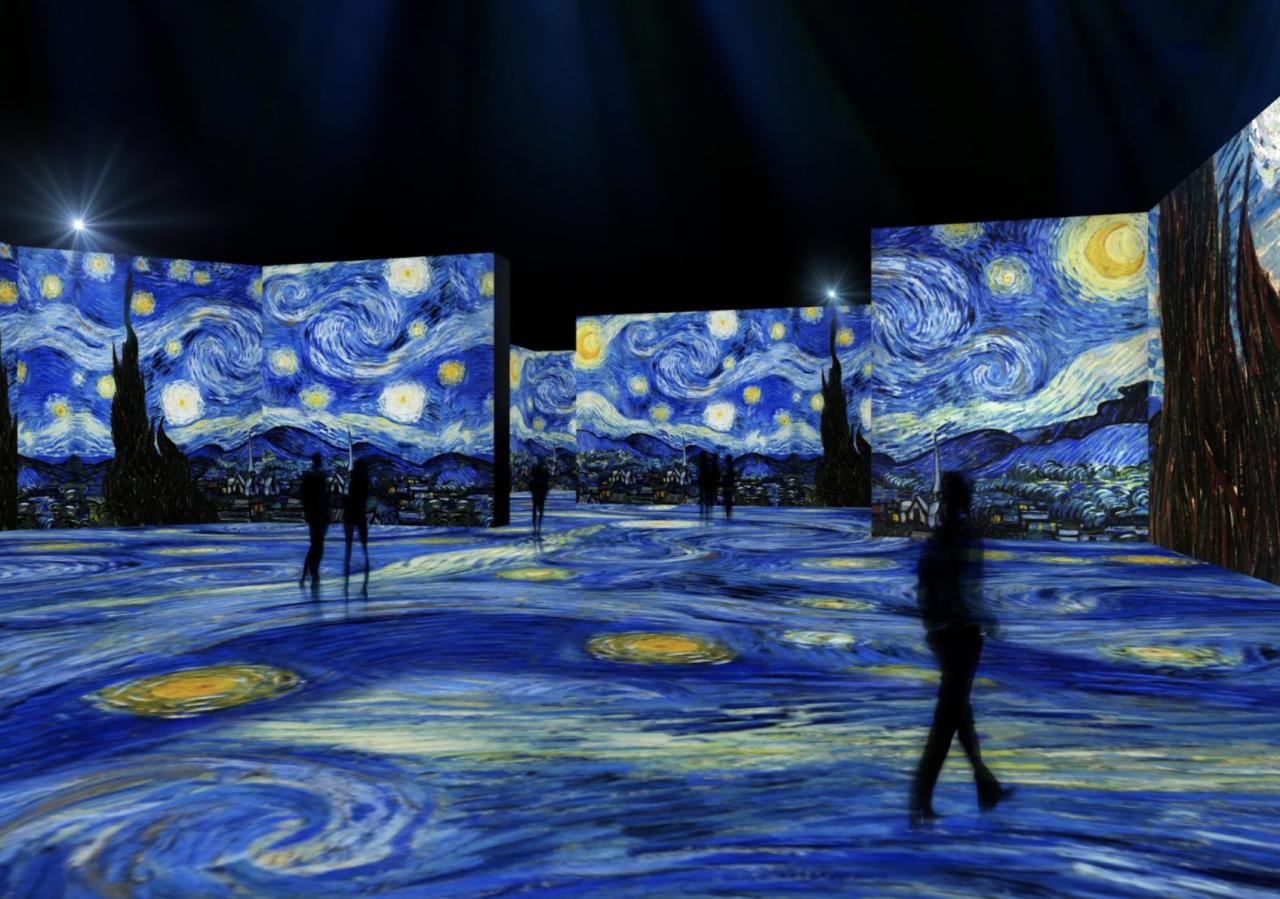Museum of Immersive Art & Technology: Where Art Meets Innovation
Museum of immersive art & technology, a captivating blend of artistic expression and cutting-edge technology, offers a transformative experience for visitors. These museums redefine the traditional art museum, immersing audiences […]

Museum of immersive art & technology, a captivating blend of artistic expression and cutting-edge technology, offers a transformative experience for visitors. These museums redefine the traditional art museum, immersing audiences in interactive environments that blur the lines between reality and digital realms. From interactive installations that respond to touch to virtual reality experiences that transport visitors to other worlds, immersive art museums offer a unique and engaging way to experience art.
These museums have gained popularity in recent years, as technology has advanced and artists have embraced new ways to engage audiences. The rise of immersive art museums reflects a growing interest in interactive and engaging experiences, particularly among younger generations who are accustomed to digital environments.
Introduction to Immersive Art & Technology Museums

Immersive art and technology museums are a relatively new phenomenon, but they are quickly gaining popularity. These museums offer visitors a chance to experience art in a whole new way, using technology to create interactive and engaging environments.
These museums use cutting-edge technology to create multi-sensory experiences that go beyond traditional art viewing. They utilize various technologies, including virtual reality, augmented reality, projections, and interactive installations, to transport visitors into different worlds and engage their senses.
Examples of Immersive Art & Technology Museums
Immersive art and technology museums are becoming increasingly common worldwide. Here are some notable examples:
- TeamLab Borderless (Tokyo, Japan): This museum features a vast, interconnected network of rooms filled with digital art installations that respond to the movements of visitors. It is a prime example of how technology can be used to create a truly immersive and interactive experience.
- Artechouse (Washington, D.C., USA): Artechouse is a digital art museum that showcases contemporary art installations created by both established and emerging artists. The museum utilizes cutting-edge technology to create immersive and interactive experiences for visitors. It is a pioneer in showcasing the intersection of art, technology, and innovation.
- The Museum of the Moving Image (New York City, USA): This museum focuses on the history and evolution of moving images, including film, television, and digital media. It features interactive exhibits that allow visitors to explore the world of cinema and understand how technology has shaped the way we experience stories.
History and Evolution of Immersive Art & Technology Museums
The concept of immersive art and technology museums has evolved over time, driven by advancements in technology and a growing interest in interactive experiences.
- Early Examples: Some early examples of immersive art experiences can be traced back to the 1960s and 1970s with the rise of kinetic art and light installations. These installations often used technology to create dynamic and engaging environments, foreshadowing the immersive art museums of today.
- The Rise of Digital Art: The development of digital art in the 1980s and 1990s further fueled the growth of immersive art experiences. Artists began using computers and digital tools to create interactive installations and virtual worlds, blurring the lines between art and technology.
- The Emergence of Immersive Art Museums: The 2000s saw the emergence of dedicated immersive art and technology museums. These museums embraced the use of technology to create engaging and multi-sensory experiences, catering to a growing audience seeking interactive and engaging art forms.
Key Features of Immersive Art & Technology Museums: Museum Of Immersive Art & Technology

Immersive art and technology museums are a relatively new phenomenon, but they are quickly gaining popularity. These museums use technology to create engaging and interactive experiences that go beyond traditional art displays. The key features of these museums are their innovative use of technology, the focus on visitor interaction, and the creation of immersive environments.
The Role of Technology in Creating Immersive Experiences
Technology plays a crucial role in creating immersive experiences in these museums. By integrating technology into art displays, these museums offer unique and engaging experiences for visitors. These technologies create a sense of wonder and curiosity, making the art more accessible and engaging for visitors.
Types of Technologies Used in Immersive Art & Technology Museums
Immersive art and technology museums utilize a wide range of technologies to create their unique experiences. These technologies include:
- Virtual Reality (VR): VR technology allows visitors to experience art in a completely different way. By wearing a VR headset, visitors can be transported to a virtual world where they can interact with art in ways that are not possible in the real world. For example, they can walk through a painting, explore a sculpture from all angles, or even interact with virtual characters.
- Augmented Reality (AR): AR technology overlays digital information onto the real world. This allows visitors to interact with art in a more engaging way. For example, an AR app could provide information about a painting, play an audio commentary, or even allow visitors to create their own digital art.
- Interactive Installations: Immersive art and technology museums often feature interactive installations that allow visitors to participate in the art. These installations can range from simple touchscreens to complex, multi-sensory experiences.
- Projection Mapping: Projection mapping is a technique that uses projectors to project images onto surfaces, creating a three-dimensional effect. This technology is often used to create immersive environments that transport visitors to different worlds.
- Sound Design: Sound design is an important part of creating immersive experiences. By using sound, museums can enhance the atmosphere and create a more engaging experience for visitors.
How Technology Enhances Visitor Engagement and Interaction, Museum of immersive art & technology
Technology plays a vital role in enhancing visitor engagement and interaction in immersive art and technology museums. The technologies used in these museums create a sense of wonder and curiosity, making the art more accessible and engaging for visitors.
- Interactive Experiences: Interactive installations and AR experiences allow visitors to actively participate in the art, rather than simply observing it. This encourages visitors to explore the art in more detail and engage with it on a deeper level.
- Personalized Experiences: Technology can be used to create personalized experiences for visitors. For example, an AR app could track a visitor’s movements and provide information tailored to their interests.
- Accessibility: Technology can make art more accessible to a wider audience. For example, VR experiences can allow people with disabilities to experience art in a way that would not be possible otherwise.
- Enhanced Learning: Technology can be used to enhance learning in museums. For example, an AR app could provide information about a painting, play an audio commentary, or even allow visitors to create their own digital art.
Artistic Expressions in Immersive Museums

Immersive museums provide a unique platform for artistic expression, pushing the boundaries of traditional art forms and embracing the transformative power of technology. These spaces offer a dynamic and engaging experience, blurring the lines between art and audience.
Types of Art Forms
Immersive museums showcase a diverse range of art forms, often blending traditional disciplines with cutting-edge technology.
- Interactive Installations: These installations allow visitors to actively participate in the artwork, influencing its evolution and creating a personalized experience. For example, the “Rain Room” by Random International invites visitors to walk through a room filled with falling water, creating a mesmerizing and interactive experience.
- Virtual Reality (VR) Art: VR technology enables artists to create immersive environments and experiences that transport viewers to different worlds. These virtual realities can range from abstract landscapes to historical simulations, offering unique perspectives and engaging storytelling.
- Augmented Reality (AR) Art: AR overlays digital elements onto the real world, creating interactive and dynamic experiences. For instance, an AR installation could project animated characters or interactive elements onto a museum wall, enhancing the visitor’s perception of the space.
- Projection Mapping: This technique projects images onto three-dimensional objects or surfaces, creating dynamic and visually stunning displays. Projection mapping is often used to transform architectural spaces into immersive environments, creating breathtaking illusions and narratives.
- Sound and Light Installations: These installations combine sound and light to create multi-sensory experiences, evoking emotions and creating immersive environments. For example, the “Wave Field” by Studio Drift uses hundreds of suspended lights that move in response to sound, creating a mesmerizing and interactive display.
Impact of Technology on Artistic Expression
Technology plays a crucial role in shaping artistic expression in immersive museums.
- Enhanced Storytelling: Technology allows artists to create immersive narratives that engage viewers on a deeper level. VR experiences, for instance, can transport viewers into the heart of a story, providing a more visceral and impactful experience.
- New Artistic Possibilities: Technology opens up new possibilities for artistic expression, enabling artists to explore previously unimaginable concepts. For example, the use of AI in art creation allows for the generation of unique and unexpected artistic outputs.
- Greater Accessibility: Technology can make art more accessible to wider audiences. VR and AR experiences can be accessed remotely, breaking down geographical barriers and allowing individuals to experience art from anywhere in the world.
Challenges and Opportunities of Immersive Art
Immersive art presents both challenges and opportunities for artists and museums.
- Technical Expertise: Creating immersive art often requires specialized technical expertise, which can be a barrier for some artists.
- Accessibility and Inclusivity: Ensuring accessibility and inclusivity for all visitors is crucial in immersive art environments. This involves considering factors such as sensory sensitivities, physical limitations, and cultural backgrounds.
- Sustainability and Environmental Impact: The use of technology in immersive art raises concerns about sustainability and environmental impact. Museums must consider the energy consumption and waste generated by their installations.
- Curatorial Challenges: Curating immersive art presents unique challenges, as traditional exhibition practices may not be suitable for these dynamic and interactive experiences.
The Visitor Experience
A visit to an immersive art & technology museum is a journey through a captivating landscape of sensory experiences, where technology seamlessly blends with art to create unforgettable moments. This journey transcends traditional museum visits, inviting visitors to actively engage with the artwork and explore its depths, resulting in a profound emotional and cognitive impact.
Emotional and Cognitive Impact of Immersive Experiences
Immersive experiences go beyond visual stimulation, engaging multiple senses and eliciting a range of emotions. The combination of light, sound, and movement creates a powerful atmosphere that can evoke feelings of wonder, awe, and even transcendence.
“Immersive experiences can create a sense of presence and embodiment, blurring the lines between the real and the virtual.”
This heightened emotional engagement enhances cognitive processing, fostering a deeper understanding and appreciation of the artwork. The immersive environment encourages active participation, inviting visitors to explore, interact, and connect with the art on a personal level.
Types of Immersive Experiences and their Effects on Visitors
The table below highlights different types of immersive experiences and their potential effects on visitors:
| Type of Experience | Effect on Visitors | Examples |
|---|---|---|
| Virtual Reality (VR) | Transportation to a different world, enhanced empathy, and heightened sense of presence. | Walking through a historical scene, exploring the depths of the ocean, or experiencing the perspective of another person. |
| Augmented Reality (AR) | Overlaying digital information onto the real world, enriching the visitor experience with interactive elements. | Viewing historical artifacts with additional information, participating in interactive games, or experiencing art installations that respond to real-time data. |
| Projection Mapping | Transforming spaces with dynamic visuals, creating immersive environments that evoke emotions and tell stories. | Projecting images onto architectural structures, creating illusions of movement, or transforming ordinary objects into captivating art installations. |
| Interactive Installations | Engaging visitors through physical interaction, encouraging exploration, and fostering a sense of playfulness. | Kinetic sculptures that respond to touch, interactive light installations, or games that invite visitors to collaborate and create together. |
Final Review
Immersive art & technology museums represent a fascinating intersection of art, technology, and human experience. These museums offer a unique opportunity to explore the boundaries of artistic expression, engage with technology in a meaningful way, and experience art in a completely new and transformative way. As technology continues to evolve, we can expect to see even more innovative and immersive experiences in museums around the world, pushing the limits of creativity and challenging our perceptions of art and reality.
Museums of immersive art and technology are captivating spaces where visitors can experience the future of art and design. These museums often incorporate cutting-edge technology, which requires skilled professionals like healthcare technology specialists. A healthcare technology specialist certificate equips individuals with the knowledge and skills needed to manage and maintain the complex systems found in these immersive environments.
From interactive installations to virtual reality experiences, the role of a healthcare technology specialist is crucial in ensuring seamless operation and visitor enjoyment within these captivating museums.




